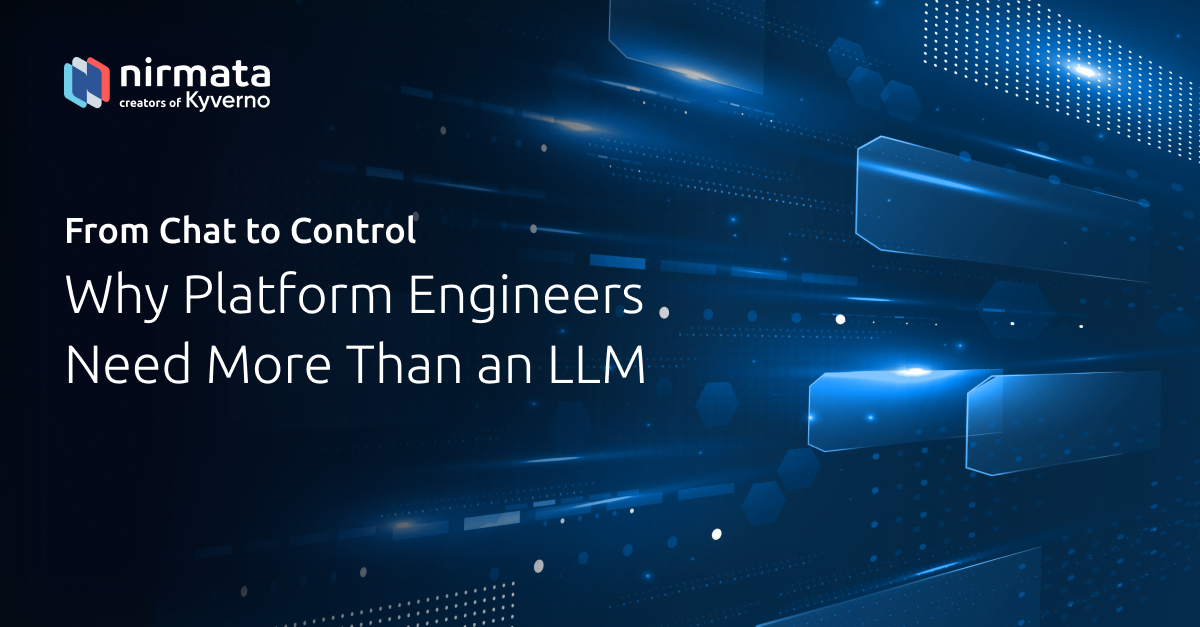
Large Language Models (LLMs) like ChatGPT, Claude, and AI-powered coding tools such as Cursor are changing how developers write and debug code. They autocomplete YAML, summarize logs, and generate Kubernetes manifests.
But platform engineering is about more than generating code — it’s about governing, securing, and optimizing the systems that run it. That’s where general-purpose LLMs fall short.
The Productivity Mirage
It’s easy to assume that adding an LLM to your workflow instantly makes your platform team more productive. But platform engineering demands precision, auditability, and control, not just fast guesses.
When managing clusters, pipelines, and cloud environments, every action must be traceable, validated, and compliant. General-purpose LLMs don’t meet these standards — and here’s why.
Why LLMs Don’t Deliver Real Platform Productivity
1. No Real Context
LLMs understand text — not systems. They don’t have live visibility into your clusters, GitOps pipelines, or policy baselines. They can generate YAML or Terraform — but can’t verify if it aligns with your admission controls, compliance policies, or organizational standards.
2. Short Memory, Long Workflows
Most platform tasks are multi-step: diagnose an issue, validate a policy, remediate a misconfiguration, and push a fix. Even the most advanced LLMs struggle to retain multi-turn context across these workflows, forcing engineers to re-prompt and re-upload context repeatedly. That’s not automation — it’s an expensive copy-paste loop.
3. Blind Confidence Without Validation
LLMs often produce configuration snippets that look right but aren’t right. Without real-time validation, they can propose insecure RBAC roles, invalid resource limits, or misconfigured network policies — all with convincing explanations. Looks right is not works right, especially in production.
4. No Audit, No Trust
In regulated industries, traceability equals trust. But most LLM-based assistants don’t log what was generated, why, or who approved it. This creates blind spots in compliance, policy provenance, and change management — unacceptable for teams subject to SOC 2, ISO 27001, or PCI DSS audits.
Operational Reality: Cost, Access, and Real-Time Enforcement
Even modern tools like Claude Code or Cursor face challenges when scaled across enterprise platform teams:
- Runaway Costs – As prompts grow to include manifests, logs, and cluster state, token consumption — and costs — rise exponentially. Without optimization, AI usage can become unpredictable and financially unsustainable.
- Access Control and Security Boundaries – Developers may have local access to kubectl, but production environments require strict role-based access (RBAC) and governed credentials. LLMs weren’t built to manage enterprise-grade authorization and auditing.
- No Central Coordination – Each user’s AI context lives in isolation. There’s no shared visibility into which recommendations were made, approved, or deployed — creating fragmented automation and governance drift.
- No Real-Time Enforcement – LLMs can suggest policies, but they can’t enforce them at runtime. Only policy engines like Kyverno can apply rules in milliseconds, evaluate thousands of admission requests, and continuously ensure compliance. LLMs can generate policy code — but not guarantee that it’s enforced or up to date.
From Chat to Control: Enter the Nirmata AI Platform Engineering Assistant
At Nirmata, we saw these gaps firsthand while helping enterprises operationalize Kyverno, the CNCF policy-as-code engine trusted by Fortune 50 teams. So we built something different — the Nirmata AI Platform Engineering Assistant — designed from the ground up for the realities of enterprise-scale, regulated platform engineering.
It’s not just another chatbot. It’s an AI system that connects natural language to policy, context, and control.
How Nirmata Bridges the Gap
| Challenge | LLM-Only Tools | Nirmata AI Platform Engineering Assistant |
| Context Awareness | Works from text only | Continuously aware of clusters, namespaces, and policies |
| Validation & Safety | Outputs unverified YAML | Runs live policy validation through Kyverno |
| Audit & Compliance | No traceability | Maintains full audit trails and compliance logs |
| Observability | Can’t see runtime data | Integrates with Kubernetes events and telemetry for accurate insights |
| Actionability | Static code suggestions | Executes remediations safely via AI agents |
| Enterprise Security | No governance | Enforces guardrails through Policy-as-Code and RBAC controls |
| Scalable Enforcement | Suggests, but can’t enforce | Uses Kyverno for low-latency, real-time policy enforcement |
Built for the Real World — and Regulated Ones
Financial services, healthcare, and government organizations can’t rely on opaque AI suggestions. They need assistants that are auditable, explainable, and controlled.
That’s why Nirmata’s AI Assistant provides:
- Full audit trails — every policy, recommendation, and change is logged and attributable
- Explainable AI — all suggestions grounded in cluster and policy context
- Policy-governed automation — actions executed within defined guardrails
- Human-in-the-loop approval — every critical recommendation or remediation can require review and sign-off by authorized engineers before execution, ensuring accountability and safety
- Continuous compliance — assurance across Kubernetes, pipelines, and cloud services
This is AI that enterprises can trust, not just chat with.
Agentic Intelligence, Not Just LLMs
The Nirmata Assistant is powered by specialized AI agents — for policy creation, remediation, optimization, and cleanup — all orchestrated through Nirmata Control Hub. These agents collaborate, closing the loop from detection → recommendation → enforcement → verification.
In other words, it’s not just AI that talks. It’s AI that acts — safely, contextually, and in control.
The Path Forward
LLMs have made AI for developers mainstream. But AI for platform engineers demands more:
- Context over code
- Control over creativity
- Audit over automation
At Nirmata, we’re building the bridge—moving platform engineers from chat to control. Because productivity without governance isn’t progress. It’s risk—automated.
Explore More
- Explore Nirmata Control Hub for automated drift reporting, governance, and remediation.
- Try Nirmata AI Platform Engineering Assistants for policy generation and remediation.
- Learn more about Kyverno policies at kyverno.io/docs.


Sorry, the comment form is closed at this time.